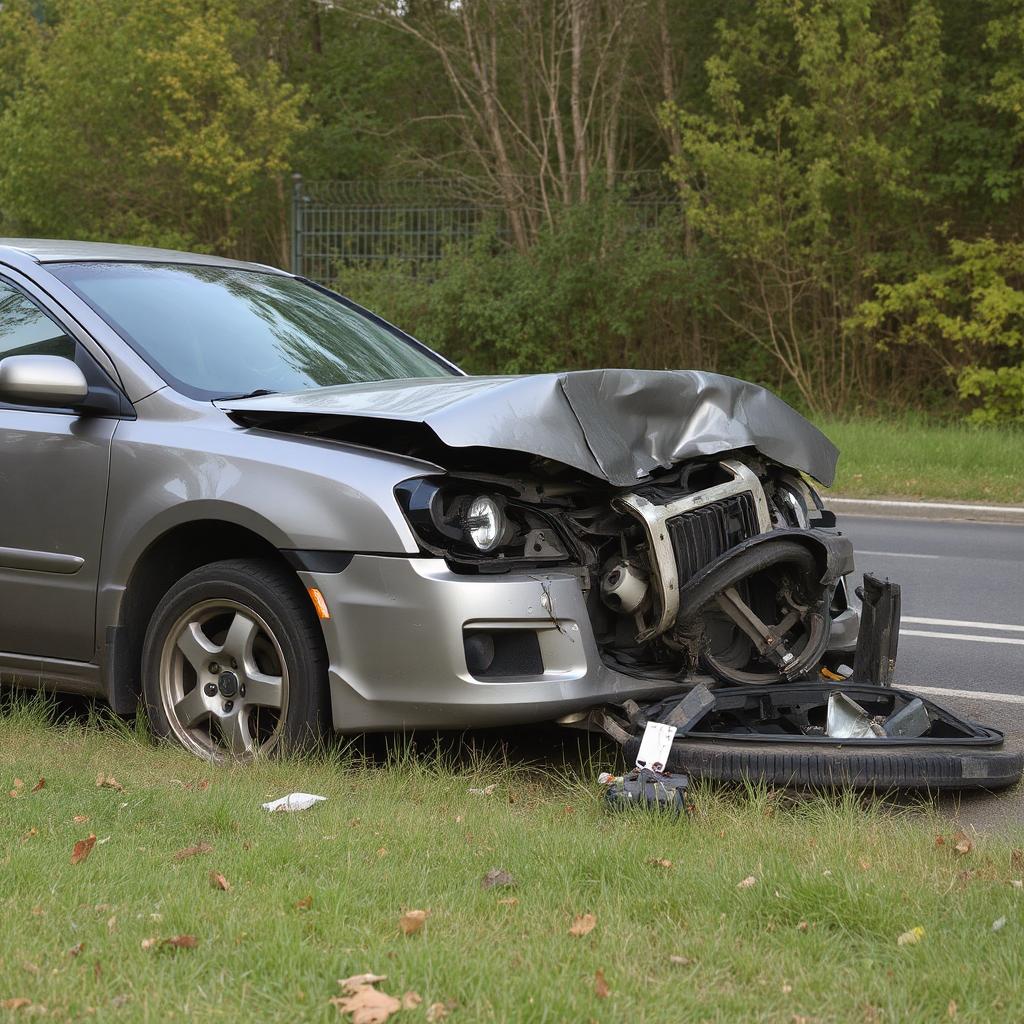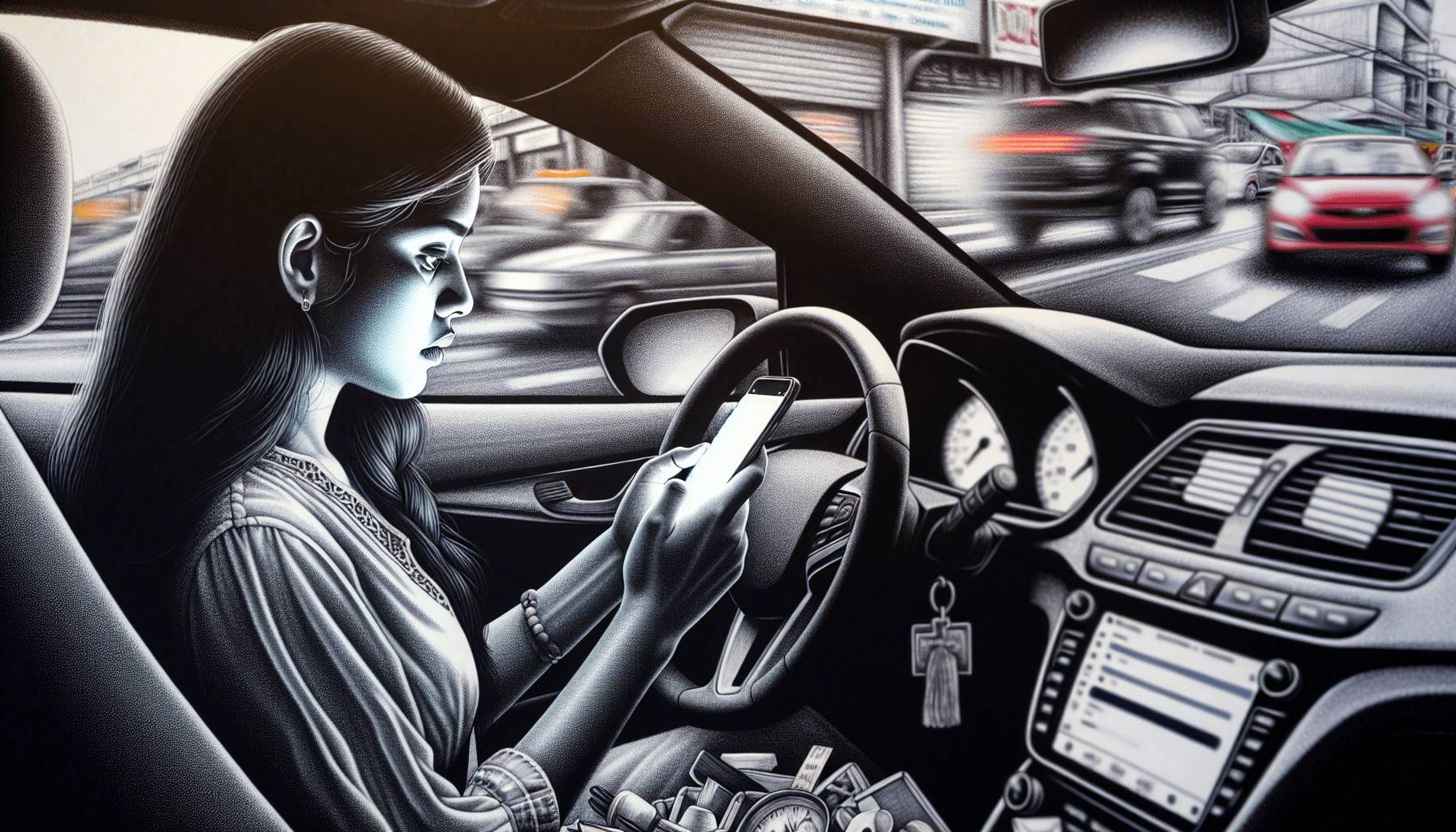
Why do car accidents happen? Understanding the common causes of car accidents, such as distracted driving and speeding, can help you stay safe. This article will cover these causes and offer tips on how to prevent them.
Key Takeaways
- Human error accounts for approximately 94% of car accidents, with leading causes including distracted driving, speeding, and drunk driving.
- Environmental factors such as poor weather conditions and road hazards, along with driver-related issues like drowsy and inexperienced driving, contribute significantly to accident rates.
- Preventive measures, including avoiding distractions, obeying traffic laws, and maintaining vehicle safety, are essential for reducing the risk of car accidents.
Most Common Causes of Car Accidents: Essential Insights to Stay Safe
Annually, the U.S. sees around 6 million car accidents, highlighting the urgency to tackle their root causes and adopt preventive strategies. Factors such as distracted driving, excessive speed, or adverse weather conditions must be understood to actively diminish accident risks and promote safer travel for all road users.
Introduction
Thousands of individuals are affected annually by the significant issue of car accidents that threaten public safety. In 2023, an alarming total of 40,990 lives were lost as a result of incidents on the road, underscoring the persistent risks encountered in daily travel. The ongoing occurrence of numerous fatal car accidents underscores the importance of sustained vigilance and instructional initiatives concerning traffic safety.
Our discussion will focus on examining the principal factors leading to vehicular collisions. These encompass aspects related to drivers, such as distracted driving and excessive speed, along with environmental conditions and mechanical issues pertaining to vehicles themselves. By understanding these causes, you can adopt precautions aimed at ensuring personal well-being and collective security—thereby contributing to a reduction in both accident rates and loss-of-life figures.
Leading Causes of Car Accidents
Approximately 94% of road accidents can be attributed to human error, making it a major factor in such incidents.
The primary causes of car accidents include:
- driving while distracted
- exceeding speed limits
- operating vehicles under the influence of alcohol
- engaging in careless or impulsive driving behaviors
- ignoring red traffic signals
In subsequent sections, we will delve into each hazard and discuss strategies tailored to mitigate these risks.
Distracted Driving
In the United States, distracted driving continues to be a major factor in car accidents, with statistics from 2022 showing 3,308 deaths and several hundred thousand injuries attributed to this issue. Often, drivers are overconfident in their ability to perform multiple tasks at once without endangering themselves or others. Engaging in activities like using a cell phone for any purpose, eating behind the wheel, or fiddling with entertainment systems can easily distract them from necessary road focus and lead to devastating outcomes.
Despite the common belief that hands-free devices might be useful for drivers who wish to multitask on the road, These tools can still draw attention away from crucial visual and auditory signals essential for safe driving practices. A widespread lack of understanding about how serious distractive behaviors while driving can be has unfortunately helped sustain its occurrence across our roads—it is imperative we acknowledge even fleeting distractions as significantly increasing the chances of being involved in an accident.
Tackling the issue of distracted driving requires developing habits centered around safety first—actively refraining from electronic device usage when operating vehicles and maintaining full concentration on navigating safely ahead are key steps towards decreasing occurrences of such incidents. Adhering strictly to these principles aids in substantially lessening numbers related specifically to accidents caused by driver distraction, thereby enhancing overall roadway security for all users.
Speeding
Excessive speed is a significant contributor to vehicle collisions. Driving above the posted limits cuts down on drivers’ reaction times, significantly diminishing their ability to adapt quickly to unforeseen road hazards. In New York in 2018, the consequences of such behavior were starkly evident, with speeding responsible for causing 274 deadly accidents.
Contrary to common assumptions, fatal crashes linked to exceeding speed limits predominantly don’t take place on interstate highways. Rather, they occur overwhelmingly (86%) on other roads. The inclination towards speeding often stems from factors like being behind schedule, trying to match the pace of traffic flow, or inadvertently going over prescribed driving speeds.
Observing designated speed limits and maintaining a prudent velocity while driving are critical practices that enhance safety across all roadway users.
Drunk Driving
The persistent issue of drunk driving continues to be a primary factor in deadly car accidents across the United States, with an average of 32 lives lost every day as a result of impaired driving. In the city of Philadelphia alone, reports indicate that over one year, approximately 1,500 accidents were attributed to drivers under the influence or intoxicated. The impairment caused by alcohol or drug use can significantly hinder a driver’s attention and ability to operate their vehicle safely, often resulting in severe consequences and fatalities.
Fatalities and disruptions from drunk driving not only impact those directly involved but also cause lasting grief for relatives and loved ones left behind. Efforts aimed at combating this problem through awareness campaigns have made some headway in mitigating its frequency. It still presents a serious challenge today. To avoid being partakers in these tragic occurrences, individuals are encouraged to arrange for alternative transportation methods when under the influence—thus circumventing potential fatal incidents on our roads.
Despite recent advancements leading to decreased mortality rates linked with drunken operation of vehicles, it is imperative that motorists persistently exercise good judgment while making safety-oriented decisions behind the wheel.Subsequent adherence will Diminish instances where intoxication plays a role, and ultimately assist us all in safeguarding precious human lives against unnecessary losses due to such preventable causes.
Reckless Driving
Dangerous actions such as aggressive lane switching, excessive speeding, and following other vehicles too closely define reckless driving. These practices elevate the likelihood of vehicular collisions by diminishing a driver’s response time and impairing their control over the vehicle. For instance, tailgating can result in rear-end crashes if the car in front comes to an abrupt halt.
Emotional states like anger or stress frequently play a role in prompting drivers to make risky choices on the road. Maintaining tranquility and self-control while operating a motor vehicle is crucial for preventing aggressive driving habits and fostering safer conditions for everyone sharing the road.
Running Red Lights
Disregarding red lights is an irresponsible act that elevates the risk of devastating T-bone crashes, commonly resulting in grave injuries or death. The chances of encountering dangerous high-speed side-impact collisions are greatly amplified when drivers fail to observe red traffic signals.
It is crucial for motorists to comply with traffic control devices such as stop signs and signals in order to avert these catastrophic events. Through adherence to these traffic management tools, we can diminish the occurrence of serious side-impact accidents and foster a safer roadway experience for all users.
Environmental and Road Conditions
Weather and road conditions significantly impact the rate of car accidents. Hazardous driving situations, which require increased caution, can arise from poor weather, obstacles on the road, and areas under construction where car accidents are more likely to happen.
It is vital for drivers to adjust their driving behavior in response to these varying circumstances to ensure safety on the roads.
Poor Weather Conditions
Inadequate weather conditions, such as precipitation, winter mixtures, and limited visibility due to fog, play a significant role in the occurrence of car accidents each year. Wet roads can lead to loss of traction for vehicles while icy surfaces produced by snow present hazardous driving situations. Fog greatly diminishes drivers’ sight range, sometimes down to less than one vehicle length ahead.
Adapting one’s driving behavior is essential during adverse weather. This includes decelerating and extending the gap between cars. When navigating through foggy environments, utilizing fog lights and abiding by a speed that meets or is below-posted limits can significantly boost safety measures on the road. It is also important for motorists in snowy regions to outfit their automobiles with appropriate tires and gear tailored for safe maneuvering under those specific conditions.
Whenever possible, it’s recommended that individuals avoid operating vehicles during extreme weather periods altogether. In instances where traversing icy terrain becomes necessary, begin braking well ahead of time before expected stops as this could mitigate potential sliding incidents effectively minimizing poor-weather-related traffic mishaps chances.
Potholes and Road Hazards
Increased rates of car accidents can be attributed to poorly maintained roads that feature potholes, which may cause tire blowouts and result in drivers losing control over their vehicles. Road debris is also a significant risk factor contributing to automotive mishaps.
To ensure safety, it’s crucial for motorists to stay alert and steer clear of such hazards whenever possible.
Construction Zones
Drivers frequently encounter confusion and danger within construction zones, where the risk of accidents is increased. This potential for disarray stems from altered traffic flows, a decrease in available lanes, and the existence of workers and machinery on site.
When entering areas of construction, it is crucial for drivers to remain alert, adhere to designated speed limits, and proceed with care. Such measures are essential for safely traversing these zones while minimizing accident risks.
Driver-Related Factors
Factors attributable to the driver, such as driving while fatigued, operating a vehicle under the influence of drugs, and insufficient driving experience, are major contributors to vehicular accidents. The tendency for poor judgment calls and an inadequate understanding of the risks associated with these actions frequently result in devastating consequences when they lead to fatal car accidents.
It is crucial to acknowledge and tackle these issues if we aim to enhance safety on our roads.
Drowsy Driving
Driving while fatigued greatly escalates the likelihood of being involved in car accidents, with an estimated 6,400 deaths annually as a result of crashes precipitated by drivers who are drowsy. Typical actions exhibited by individuals driving under such conditions range from overlooking pedestrians to disregarding red lights or even dozing off while operating the vehicle.
It is imperative that motorists cease driving upon experiencing exhaustion and ensure they take adequate breaks to recuperate.
Drugged Driving
Operating a vehicle while under the influence of drugs, including prescribed medications and illicit substances, may result in grave car accidents. It’s essential to recognize how these medications can impact one’s capacity to drive safely and seek advice from a healthcare professional when in doubt.
Drivers can maintain their own safety as well as that of other road users by staying alert to the potential for drug-related impairment behind the wheel.
Inexperienced Drivers
Due to their minimal experience and occasional inclination towards hazardous actions, young drivers are frequently implicated in car accidents. Especially vulnerable are teenage drivers who, because of their novice status and proneness to risk-taking, regularly find themselves in fatal crashes.
This mix of a lack of experience with imprudent conduct positions young motorists as a major road safety worry.
Vehicle-Related Issues
Regular maintenance of vehicles is essential to avoid incidents like tire blowouts, mechanical malfunctions, and flaws in design that can result in major accidents. To maintain conditions conducive to safe driving, it’s critical to prevent such problems through consistent vehicle upkeep.
Tire Blowouts
Tire blowouts often occur due to insufficient inflation, extensive tire wear, and neglecting to rotate the tires regularly. These factors can diminish the safety of your vehicle. It is imperative to maintain control of the vehicle during a tire blowout and proceed with caution until you are able to pull over safely.
Consistent maintenance of tires—such as conducting regular checks and replacing them when necessary—is key in averting unexpected tire blowouts.
Vehicle Malfunctions
Regular vehicle maintenance proactively tackles potential issues, such as brake or engine failures, ensuring that all components function properly. This reduces the risk of dangerous road situations and accidents resulting from vehicle malfunctions.
Proactively correcting these deficiencies is crucial for improving road safety.
Tips to Prevent Car Accidents
Maintaining safe driving practices, obeying road rules, and ensuring your vehicle is regularly serviced are critical measures in reducing car accidents. By steering clear of distractions, complying with traffic regulations, and keeping cars well-maintained, the likelihood of incidents on the roads can be significantly diminished, promoting a secure environment for all drivers.
Avoid Distractions
To prevent the consequences of distracted driving, motorists should limit their use of electronic gadgets in urgent situations and stop their vehicles before making phone calls. Reducing other distractions, such as tuning the radio or engaging in conversations with fellow passengers, can help drivers maintain complete focus on driving.
Obey Traffic Laws
Adhering to traffic regulations, including obeying speed limits and signals, is essential for minimizing the risk of accidents. Compliance with these rules contributes to a safer driving atmosphere and helps avoid vehicular crashes.
Maintain Your Vehicle
Ensuring your vehicle undergoes regular maintenance is essential to maintain its good condition, which is paramount for safe driving. Such checks are vital for confirming that your vehicle operates correctly and remains secure on the road, thus averting potential mechanical breakdowns that might result in accidents.
Get the Legal Support You Need – Contact Jeffrey Weiskopf, P.C. Today!
Should you or someone close to you suffer harm from a car accident, or if bereavement has struck your family as the result of another’s carelessness, it is vital to pursue legal counsel. Reach out to Jeffrey Weiskopf, P.C., without delay by dialing 914-350-5175 and arranging a complimentary consultation. This initial step will put you on the path toward obtaining rightful compensation.
You can find us poised to provide support at our premises located at 30 State St, Suite 2B in Ossining, NY 10562. Our team is dedicated to guiding you through every phase of this process.
Summary
Understanding the most common causes of car accidents, such as distracted driving, speeding, and poor weather conditions, is essential for improving road safety. By taking proactive steps, such as avoiding distractions, adhering to traffic laws, and maintaining your vehicle, you can significantly reduce the risk of accidents.
Remember, safe driving habits not only protect your life but also the lives of others on the road. Stay vigilant, make responsible choices, and encourage others to do the same. Together, we can create a safer driving environment for everyone.
Frequently Asked Questions
What is the leading cause of car accidents in the United States?
In the United States, numerous fatalities and injuries from car accidents each year are primarily attributed to distracted driving, which is recognized as the foremost cause of these incidents.
To improve road safety, it is essential to concentrate on driving and reduce distractions behind the wheel.
How does speeding contribute to car accidents?
Speeding significantly reduces reaction time, escalating the risk of accidents and contributing to many fatal crashes, especially on non-highway roads.
Therefore, adhering to speed limits is crucial for safety.
What can be done to prevent drunk driving accidents?
To avert accidents caused by drunk driving, it is crucial to refrain from drinking alcohol before operating a vehicle, employ the use of a designated driver, and fervently endorse campaigns against drunk driving.
These decisions are pivotal in safeguarding oneself and others while simultaneously fostering accountability amongst community members.
How do poor weather conditions affect driving safety?
Inclement weather severely undermines the safety of driving by elevating accident risks because it decreases both visibility and road grip.
To safely overcome these difficulties, drivers must adjust their behavior on the roads and confirm that their vehicles are in good condition.
Why is regular vehicle maintenance important for preventing accidents?
Regular vehicle maintenance is essential for preventing accidents, as it minimizes the risk of mechanical failures like tire blowouts and brake issues.
Keeping your vehicle in optimal condition directly contributes to safer driving experiences.




